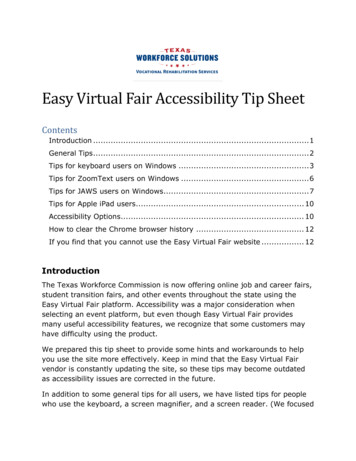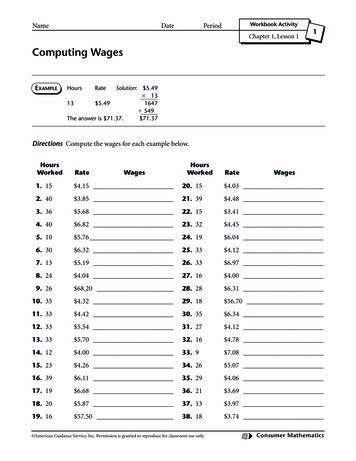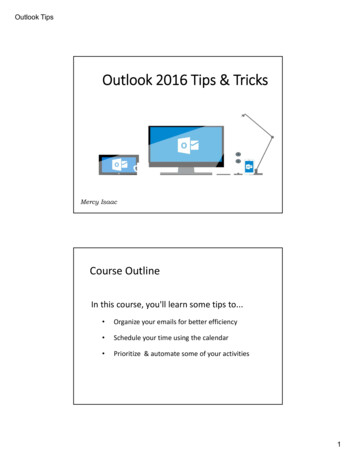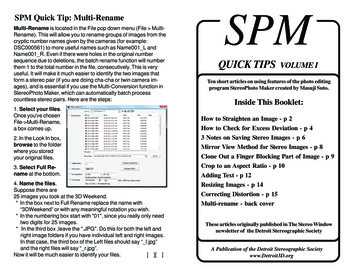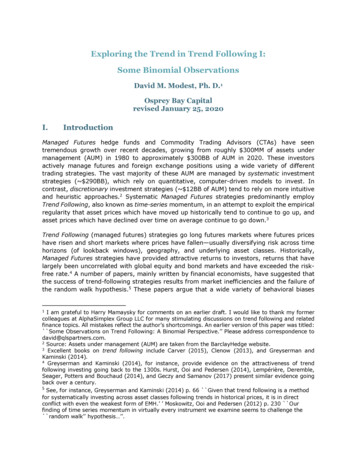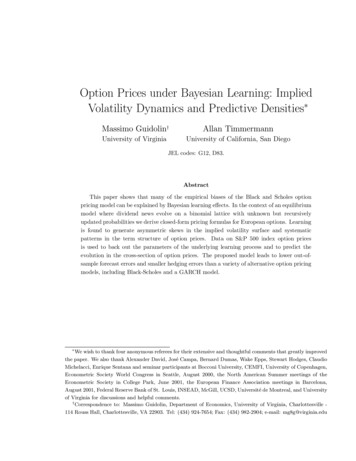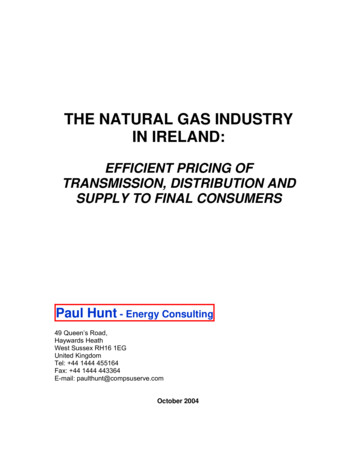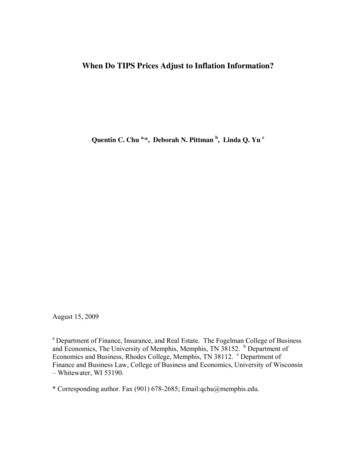
Transcription
When Do TIPS Prices Adjust to Inflation Information?Quentin C. Chu a,*, Deborah N. Pittman b, Linda Q. Yu cAugust 15, 2009aDepartment of Finance, Insurance, and Real Estate. The Fogelman College of Businessand Economics, The University of Memphis, Memphis, TN 38152. b Department ofEconomics and Business, Rhodes College, Memphis, TN 38112. c Department ofFinance and Business Law, College of Business and Economics, University of Wisconsin– Whitewater, WI 53190.* Corresponding author. Fax (901) 678-2685; Email:qchu@memphis.edu.
When Do TIPS Prices Adjust to Inflation Information?AbstractThe trading of Treasury Inflation-Protected Securities (TIPS) provides a uniqueset of market price data to investigate when security prices adjust to inflation information.After controlling for changes in the real rate, changes in the reference Consumer PriceIndex (CPI), and the weekday effect, the seemingly random fluctuation of daily TIPSholding period returns start to reveal the pattern of TIPS price adjustment to inflationinformation. The study finds that TIPS prices adjust to inflation information during theprice survey period, which precedes CPI announcement by 22 to 42 trading days. TIPSprices also make a significant adjustment on the CPI announcement day. The findingsare based on regression analysis of time-series cross-section data from three maturingTIPS. Furthermore, bootstrap results are used as a benchmark to gauge the robustness ofour empirical findings. The empirical evidence presented in this paper is consistent witha TIPS market where TIPS price adjustment is concurrent with the change in consumerprice.
When Do TIPS Prices Adjust to Inflation Information?1. IntroductionThe adjustment of Treasury Inflation-Protected Securities (TIPS) prices to themonthly update of the Consumer Price Index (CPI) is investigated using three maturedTIPS with maturities occurring in January 2007, January 2008, and January 2009. In anefficient market, security prices adjust to new information instantaneously. TIPS pricesare linked to the CPI and are expected to adjust to inflation information. The Bureau ofLabor Statistics follows a monthly cycle lasting for about 45 trading days to update theCPI. The monthly cycle includes a price survey period to sample retail prices and anannouncement of CPI about four weeks after the price survey period. This study asks thequestion when TIPS prices adjust to inflation information. The hypotheses state that theadjustment of TIPS prices occurs concurrently with the consumer price survey period aswell as TIPS prices react to the CPI announcement and make the final adjustment toinflation information.The trading of TIPS provides a unique set of market price data to answer theresearch question. We use a regression model to investigate the timing of TIPS priceadjustment to inflation information. The regression model utilizes TIPS prices over athree-year period from each of three matured TIPS issues. We draw our time-seriescross-section data from the last three years of maturing TIPS prices to reduce the noiseassociated with changing long run real rate expectations. To avoid the last few monthswhen a TIPS issue gradually transforms from an inflation hedge security into a Treasurybill, the study periods end four months before maturity dates. The regression model
investigates the impact of market determined measures of unexpected inflation on TIPSdaily holding period return (HPR) over a 51-day window, beginning 45 business daysprior to a monthly CPI announcement and continuing through five business days after theannouncement. Our regression model also includes three control variables that affect thechange in the daily HPR of TIPS: (1) changes in the real rate of interest (DRY), (2)changes in the historical inflation reference index that adjusts nominal prices of TIPS forinflation (DRATIO), and (3) a set of dummy variables (DumDay) to indicate weekdayeffect on daily HPR.This study finds that TIPS prices do adjust to inflation information during theconsumer price survey period, which precedes CPI announcement by 22 to 42 days. Wealso find a significant price adjustment on the announcement date.2. Factors Influencing TIPS PricesThe cash flows associated with TIPS are directly tied to the announced inflation.TIPS prices, which are free from default risk and are protected against inflation, provide aunique set of market data to observe how security prices adjust to inflation information.When TIPS matured on January 15, 2007, the final redemption payment on the paramount was adjusted for all the inflation since the TIPS were issued in January 1997.This is accomplished by multiplying the stated par amount by the ratio of reference CPItied to the redemption date over the reference CPI for the issuance date. Each semiannual coupon payment is adjusted the same way.Since the cash flow to be paid depends on actual cumulative inflation, the TIPSprice reacts much differently over time than the conventional bond. While the2
conventional bond price will respond to changes in the expected rate of inflation andchanges in the real rate, the TIPS will respond only to changes in past inflation andchanges in the real rate, assuming contemporaneous adjustment of the contractual cashflow to the current CPI.However, the adjustment of TIPS contractual cash flow is not contemporaneous.The market relies on repeated trading to synthesize inflation information and on theannouncement of CPI to make the final price adjustments. For example, April 2007 CPImeasures price level occurring between March 15, 2007 and April 15, 2007. The April2007 CPI was released on May 15, 2007. The retail price survey period for April 2007CPI covers 22 to 42 business days before the official announcement of April 2007 CPI onMay 15, 2007.1The study window covering 48 days around a CPI announcement date is separatedinto four periods.2 Period I coincides the monthly CPI retail price survey period whichcovers around 22 days to 42 days prior to a CPI announcement date. Period II runs from21 days to 1 day before a CPI announcement date. In period II, Bureau of LaborStatistics processes price data collected from the survey period. The CPI announce dateis the period III. Period IV covers the five days after a CPI announcement date.Given the structure of the TIPS contract with the investor, we expect that theholding period return has a positive correlation with realized inflation reflected in thechange in the reference CPI, and that it has a negative correlation with the change in real1A typical chronology of monthly CPI announcement cycle is presented in Schwert (1981), p. 21.2The observation window covers 51 days around a CPI announcement date, i.e., 45 days before and 5 daysafter a CPI announcement date. The study window is 3 days shorter than the observation window, i.e., 42days before and 5 days after a CPI announcement date.3
return. The Treasury security market requires one business day to settle a transaction.The HPR on Friday includes at least 3-day accrual interest yield until the first businessday in the following week. The TIPS daily HPRs are expected to have a weekly patternin which Friday is expected to have a larger HPR. After controlling for these threefactors, we design a regression model to reveal when TIPS prices adjust to inflationinformation. Specifically, we are asking how much of the TIPS holding period returnsare associated with unexpected inflation during each of the four observation periods.3. Literature ReviewThere is a small body of research that has used market securities to investigate themarket’s ability to aggregate information about inflation. Schwert (1981) addressed theinformation aggregation of inflation into the stock prices, and found a weak support forthe hypothesis that composite stock prices adjust to new inflation information during theprice measurement period. Huberman and Schwert (1985) used Israeli bonds indexed toits CPI to test whether announcements of CPI were already reflected in the indexed bondprices. They find that 85 percent of the reaction to inflation information occurs from 2 to5 weeks before the announcement, i.e., when the inflation is occurring. They found nosignificant relationship between unexpected inflation and indexed bond returns during thetwo weeks after the month is ended and before the announcement is made. On the dayafter the announcement they made the final 15% adjustment. Their conclusion is thatindex-linked bond prices do absorb most of the information as the price level is changing,but there is some portion which is missed and is assimilated only after publicannouncement.4
Chu (1991) used the short-lived inflation futures prices (1985-1986) to examinethe timing and speed with which inflation futures prices absorb inflation information.The research measures the expected and unexpected components of the inflation rate byidentifying a time series inflation rate model based on past inflation rates. The timeseries model is used to predict inflation of the next month. Any difference between thepredicted inflation and the actual inflation which was subsequently announced is treatedas the unexpected inflation. Chu (1991) found that inflation futures prices reflect 71percent of unexpected inflation about 25 business days prior to the CPI announcement,which coincides with the end of the inflation measurement period. The remaining 29percent occurs on and shortly after the CPI announcement date.Both studies conclude that while the markets involved are not perfectlyaggregating information, they are efficient in absorbing a great deal of inflationinformation into the price of the underlying security far in advance of the announcementdate.Previous studies using Israeli indexed bond price data have several problems.Some of the Israeli bonds are only partially indexed with respect to principal and none ofthe coupon payments are indexed, rendering the bonds less effective as an inflation hedgesecurity. Also there is a default premium in the Israeli bonds’ returns which may biasresults of the test. Moreover, the Israeli government does intervene in the bond market(Huberman and Schwert, 1985), with indexed bonds representing the 67% of governmentbonds outstanding in 1976. The inflation futures contract used by Chu (1991) overcomesthese problems, but the contract had a relatively short trading history and never enjoyed alarge trading volume.5
Our study is the first attempt to document when TIPS prices adjust to inflationinformation. In a survey paper, Thomas (1999) indicates that proxies for expectations ofinflation are problematic, and that there is no consensus on whether surveys or time seriesmodels or macroeconomic models are the best estimator. This study uses a marketgenerated measure of inflation expectations just as Kandel, Ofer, and Sarig (1993) did.The expected inflation on a specific date is measured by the breakeven inflation rate, i.e.the nominal yield to maturity on a constant five-year conventional Treasury bond minusthe real yield to maturity on a constant five-year TIPS.4. The Regression Model and HypothesesThe dependent variable in the regression model is the time-series of daily holdingperiod return (HPR) from three individual TIPS issues. To fully utilize all three maturingTIPS issues (TIPS2007, TIPS2008, and TIPS2009), the regression model analyzes apooling of time-series cross-section data. Table 1 summarizes the time-series crosssection HPRs. The study covers a time span of 1,268 trading days starting September 2,2003 through September 12, 2008. TIPS2007 has 767 trading days covering September2, 2003 through September 15, 2006. TIPS2008 has 765 trading days coveringSeptember 1, 2004 through September 14, 2007. TIPS2009 has 763 trading dayscovering September 1, 2005 through September 12, 2008. In total, the pooling data sethas 2,295 trading day records.The total 1,268 trading days are separated into five cross-section periods.TIPS2007 was the sole TIPS security traded in period 1 (September 2, 2003 throughAugust 31, 2004, 252 trading days). Two TIPS securities, TIPS2007 and TIPS2008 were6
traded in period 2 (September 1, 2004 through August 31, 2005, 253 trading days). Allthree TIPS issues were traded in period 3 (September 1, 2005 through September 15,2006, 262 trading days). TIPS2008 and TIPS2009 were traded in period 4 (September18, 2006 through September 14, 2007, 250 trading days). Finally, TIPS2009 was the soleTIPS issue traded in period 5 (September 17, 2007 through September 12, 2008, 251trading days).The following regression model is used to identify the timing of TIPS priceadjustment to inflation information.HPRYr ,t α β (DRYt ) γ (DRATIO t ) i 1θ i ( DumDayi ,t ) k 45 δ kU k ,t μYr ,t45t 1, 2, .,1268, Yr 2007, 2008, 2009.(1)whereHPR Yr,t:DRYt:DRATIOt:the daily nominal holding period return for TIPS Yr issue on the t-th date;daily change in real interest rate, a control variable;daily change in the ratio of reference CPI over base CPI, a controlvariable;DumDayi,t : dummy variables to indicate weekday for the t-th date, a control variable;U k ,t :the monthly inflation surprise if the t-th date is k days away from a CPIannouncement date; zero otherwise;k:a negative number means k days prior to a CPI announcement date; apositive number means k days after a CPI announcement date; and zeromeans a CPI announcement date;μ Yr ,t :a disturbance term for the TIP Yr issue on the t-th date;α , β , γ ,θ i ' s : the regression coefficients for control variables;7
δ k 's :the regression coefficients revealing the adjustment of TIPS prices toinflation information.Holding period return measures daily realized return if an investor purchases TIPS on dayt-1 and sell the same TIPS on day t. Daily HPR for an issue of TIPS is computed asfollows:HPR t Pt Pt 1 (nomial coupon payment on ex - coupon day, zero otherwise)Pt 1(2)where reported clean price I Pt c days between settlement date and the last coupon payment date t IBdays between coupon payment dates 2 (3)Pt is nominal invoice price of a TIPS issue on observation date t; c is annual coupon inteal term; I t is the reference CPI for the observation date; and I B is the reference CPI forthe original dated issue date. DRY is measured by daily change in 5-year constantmaturity real rate.The monthly unexpected inflation rate is obtained by subtracting the monthlyexpected rate from the actual monthly rate. The monthly expected rate is measured bythe breakeven inflation rate divided by 12. The breakeven inflation rate is defined as theyield spread between 5-year constant maturity nominal and real rates.We use observation date July 20, 2007 for TIPS issue maturing on January 15,2008 as an example to explain the 51-day observation window and the structure ofindependent variables U k ,t ' s. The observation date on July 20, 2007 is 42 trading daysbefore the announcement of August 2007 CPI on September 19, 2007. The U 42,t forobservation date on July 20, 2007 is the actual monthly inflation rate for August 20078
minus the expected inflation measured by the one twelfth of the breakeven inflation rateobserved on July 20, 2007. Similarly, July 20, 2007 is 18 trading days before theannouncement of July 2007 CPI and 2 trading days after the announcement of June 2007CPI. U 18,t and U 2 ,t are computed according to the same procedure for observation dateon July 20, 2007. According to the definition of unexpected inflation, the rest of 48U k ,t ' s. for observation date on July 20, 2007 are set to zero.We examine a observation window of 45 days before and 5 days after a CPIannouncement date. The regression coefficients for the three control variables areexpected to be significantly different from zero. The regression coefficient for thecontrol variable DRYt is expected to be significantly less than zero, i.e., β 0. The TIPSHPR is negatively related to changes in the real interest rate. An increase in the realinterest rate results in a decrease in real and nominal prices of TIPS and subsequently anegative HPR. The nominal price of TIPS increases as the reference CPI increases. HPRis expected to be positively related to an increase in the ratio of reference CPI over baseCPI. The regression coefficient for the control variable DRATIOt is expected to besignificantly greater than zero, i.e., γ 0. The regression coefficients for the set ofdummy weekday variables (DumDayi‘s) are used to reflect weekday effect due to thesettlement procedure used in the TIPS market.The specification of the regression model enables us to test timing hypotheseslinked to the four study periods. First, if the TIPS HPR reflects new flow of informationabout inflation during the retail price survey period, the summation of regressioncoefficients for unexpected inflation over the price survey period should be significantlydifferent from zero. The monthly price survey period covers around 22 to 42 business9
days prior to the announcement date. The priori hypothesis of the timing of TIPS priceadjustment states that ( k 42 to 22 )δ k is greater than zero.Second, the time period between 21 days to one day before a CPI announcementdate, Bureau of Labor Statistics processes retail price data collected from the surveyperiod. In a market that processes inflation information efficiently, a priori hypothesisstates that ( k 21 to 1)δ k is insignificantly different from zero.Third, the regression coefficient δ 0 measures the reaction of TIPS price to the CPIannouncement. Except for the case of perfect foresight about inflation, the CPIannouncement is expected to carry new inflation information and TIPS price adjustment.A priori hypothesis states that δ 0 is greater than zero. Finally, in an efficient market, noadditional TIPS price adjustment is expected after the CPI announcement. Wehypothesize that ( k 1 to 5 )δ k is insignificantly different from zero. Table 2 summarizesthe four priori hypotheses.5. Econometric Issues and MethodologyTwo econometric issues are in order. First, the regression model uses time-seriescross-section data to estimate regression coefficients and perform hypothesis tests. Foreach trading day, there may be one, two, or three TIPS issues in the panel data. If thenumber of TIPS issues are greater than one, TIPS prices are subject to contemporaneousmarket disturbance across TIPS issues and their regression disturbance terms at anobservation date t, μ Yr ,t ' s, are highly correlated. Ordinary least squares estimators areunbiased but their variance-covariance matrix is inefficient. In estimating an efficient10
covariance structure, White (1980) heteroscedasticity consistent estimator is applied tocontrol for both contemporaneous correlation and heteroscedasticity. The correlationamong various TIPS residual terms on an observation date is allowed to change overtime. The variance-covariance matrix is estimated by ( X ′X ) 1 t ( X t' μˆ t μˆ t' X t )( X ′X ) 1 ,where X is the regression design matrix, Xt is the cross-sectional explanatory variables forthe t-th date, and μ̂ t is residual vector estimated from separate autoregressive modelapplied to individual TIPS time series data.Second, after controlling for the presence of cross-sectional correlation amongTIPS issues, the time-series cross-section data are still subject to the autocorrelationproblem. We apply nonparametric bootstrapping methods to examine the robustness ofhypothesis tests using White heteroscedasticity consistent variance-covariance estimator.Davison and Hinkley (2006) describe the details of bootstrapping method to resampleregression error terms. To maintain the original structure of time-series cross-sectiondata, the resampling error terms are restricted to same weekday and same time periodspecified in Table 1 panel B.6. Data and ResultsWe investigate three maturing issues of TIPS with maturities on January 15 2007(TIPS 2007), January 15 2008 (TIPS 2008), and January 15 2009 (TIPS 2009). When thethree Treasury securities were issued, all of them had 10 years maturity. Daily real cleanprice series for TIPS, 5-year constant maturity real and nominal interest rates are11
retrieved from Datastream database.3 Historical time series CPI and announcement datesare available at the Bureau of Labor Statistics website. Reference CPI and base CPI for aspecific issue of TIPS are retrieved from the TreasuryDirect website.Our study periods include three years of trading history before each TIPS maturitydates. The TIPS have a three-month lag in indexing their coupon and principal payments.The inflation hedging property of a TIPS issue expires three months before the maturitydate. To avoid the last few months when a TIPS issue gradually transforms from aninflation hedge security into a Treasury bill, the study periods end four months beforematurity dates.Table 3 summarizes the mean and standard deviation values for the variables usedin the regression models. The average daily HPRs for the three TIPS issues are 0.0148%,0.0136%, and 0.0198%. In terms of nominal annual yields, the three average HPRs areequivalent to 3.73%, 3.43%, and 4.99%, respectively. The average 5-year constantmaturity real rates for the three TIPS study periods are 1.49%, 1.89%, and 1.84%. Theaverage real rates are relatively low compared with conventional estimates between 3%and 4% using annual growth rate of real gross national product. The average 5-yearconstant maturity nominal rates for the three TIPS issues are 3.93%, 4.35%, and 4.19%.We also report summary statistics for daily changes in real rates (DRY), daily changes inthe ratio of reference CPI over base CPI (DRATIO), and actual monthly percentagechange in CPI.The HPR is calculated based on TIPS nominal invoice price and the accruednominal coupon payment. Figure 1 shows the time series pattern of holding period return3Federal Reserve compiles and publishes daily 5-year constant maturity real and nominal interest rates.Datastream includes the time series in its database.12
for the three maturing TIPS during their respective time spans. Similar to other riskysecurities, the HPR for TIPS fluctuates over time to reflect the changes in real rate andinflation information. As a general trend, the fluctuation in HPR attenuates as a TIPSissue approaches its maturity date. The attenuation patterns reflect the decrease induration as the time to maturity of a TIPS issue decreases.Table 4 reports regression coefficients for control variables. For an individualTIPS, SAS AUTOREG procedure is applied to estimate regression coefficients forcontrolling variable. The AUTOREG procedure specifically recognizes the presence ofautocorrelation in individual TIPS time-series residual terms. Consistent with our priorexpectation the β coefficient for the control variable DRY is significantly less than zero.The TIPS HPR is negatively related to changes in the real interest rate. An increase inthe real interest rate leads to a decline in TIPS prices and subsequently a negative HPR.On the other hand, TIPS nominal price increases as reference CPI increases and viceversa. Consistent with our expectations, we found a positive and statistically significantrelationship between TIPS prices and reference CPI. The coefficient estimates for thecontrol variable DRATIO varies from 0.344 to 0.605. The statistically significantregression coefficients for β and γ are observed for all three issues.The estimated regression coefficients for weekday dummy variables show thatFriday consistently has the highest HPRs, which reflect the settlement procedure used inthe TIPS market. The estimated first order autoregressive parameter, φˆ1 , is significantlygreater than zero for all three TIPS time-series regression models. After adjusting for thefirst order autocorrelation, the regression models for individual TIPS issues are free fromautocorrelation problem as indicated by the reported Durbin-Watson statistics in Table 4.13
Table 4 also reports the pooling time-series cross-section results for controlvariables. Ordinary least squares method is used to estimate regression coefficients forcontrol variables. The estimated standard errors are selected from White (1980)heteroscedasticity consistent variance-covariance estimator to control for bothcontemporaneous correlation and heteroscedasticity. The results for pooling data arerobust with respect to results from individual TIPS time-series data. TIPS HPRs arenegatively related to change in real interest rate, positively related to the daily change inthe ratio of reference CPI over base CPI, and a larger HPR on Friday due to the TIPSsettlement procedureFour priori hypotheses summarized in Table 2 test when TIPS prices reflect newflow of information about inflation during the four study periods. We calculate a timeseries of the cumulative sum of the estimated regression coefficients δˆ' s over a 51-dayobservation window. The window runs from 45 days before through 5 days after a CPIannouncement date. Figure 2 plots the cumulative sum of the estimated coefficients forthe 2007, 2008, and 2009 maturing TIPS and the pooling time-series cross-section datawith the horizontal axis representing number of days before or after an announcementday. All four time-series of cumulative sum of coefficients show similar pattern. Thepattern reveals a significant portion of the unexpected inflation has been reflected in TIPSprices 22 days prior to CPI announcement.The sum of estimated coefficients for δ 42 through δ 22 reflects new flow ofinformation about information during the price survey period. A statistically significantpositive ( k 42 to 22 )δˆk indicates new information about inflation is being incorporatedinto TIPS prices as they occur. Our pooling data show that the estimated14
( k 42 to 22 )δˆk is 0.408. The t-statistics for testing the null hypothesis ( k 42 to 22) δ k 0is 4.79, which is significantly greater than zero at the 1% level. Similar sum ofcoefficient estimates and student-t statistics are computed to test priori hypotheses for theother three study periods. The estimated ( k 21 to 1)δˆk , δˆ0 , and ( k 1 to 5 )δˆk are 0.034,0.092, and 0.009, respectively. The corresponding student-t statistics for Period II, III,and IV are 0.43, 4.50, and 0.24, respectively.The error terms used to compute the White heteroscedasticity consistent variancecovariance matrix are extracted from individual autoregressive regression models forthree TIPS issues. As the Durbin-Watson statistics reported in Table 4, the extractederror terms from the first order autoregressive regression model are free from theautocorrelation problem. As an alternative approach to examine the robustness of thereported t-statistics for testing the four hypotheses, we apply bootstrap method byresampling regression residual terms with replacement. The bootstrap resamplingprocedure permutes the regression error terms. Ordinary least squares method is used tocompute regression residual terms and subsequently the estimation of the variancecovariance matrix. Based on 1,000 simulation runs, Table 5 shows the comparisonbetween sample estimates and bootstrap results. The sample estimates are close to thebenchmark results derived from the bootstrap method. Our empirical results are robustwith respect to autocorrelation problem observed in the TIPS regression models.7. ConclusionsWe analyze the timing to incorporate inflation information into TIPS prices. Fouror five weeks after the change in consumer price for a particular month has been15
measured, the CPI is announced. The cash flow of the TIPS is impacted by the inflation,and this security provides a rare opportunity to observe directly, through a market-baseddaily measurement, when the TIPS prices adjust to inflation information. The timing ofadjustment of TIPS prices to monthly update of CPI was revealed for maturing TIPSprices once we control for changes in the real rate, changes in the reference CPI and theweekday effect. Three overlapping three-year study periods are drawn from threematuring issues of TIPS, and a regression model identifies when TIPS holding periodreturns are correlated with daily inflation surprise. The inflation surprise is measured bythe actual inflation minus the expected inflation. Previous research in this area has usedtime series models to predict the expected inflation series. In contrast, this study obtainsinflation expectations from the yield spread between the nominal Treasury securities andthe TIPS of the same maturity, i.e. breakeven inflation using actual market prices.Our results indicate that the TIPS market is efficient in aggregating inflationinformation. Using the pooling time-series cross-section data from three matured TIPSissues, TIPS prices start reacting to inflation during the price survey period. A significantportion of unexpected inflation has been incorporated into TIPS prices by the end of theprice survey period. TIPS prices adjust any misinterpretation about inflation on the CPIannouncement date. Bootstrap results are used as a benchmark to gauge the robustness oft-statistics for hypothesis tests. This paper presents the empirical evidence andcontributes to the understanding of when information about inflation is incorporated intoTIPS whose future cash flows are linked to inflation. The empirical evidence presentedin this paper is consistent with a TIPS market where TIPS price adjustment is concurrentwith the change in consumer price.16
ReferencesChu, C., 1991, Futures prices and inflation information. Review of Quantitative Financeand Accounting 1, 281-291.Davison, A. C. and Hinkley, D. 2006 Bootstrap methods and their applications,Cambridge: Cambridge Series in Statistical and Probabilistic Mathematics.Huberman, G. and G. W. Schwert, 1985, Information aggregation, inflation, and thepricing o
and Economics, The University of Memphis, Memphis, TN 38152. b Department of Economics and Business, Rhodes College, Memphis, TN 38112. c Department of Finance and Business Law, College of Business and Economics, University of Wisconsin - Whitewater, WI 53190. * Corresponding author. Fax (901) 678-2685; Email:qchu@memphis.edu.





